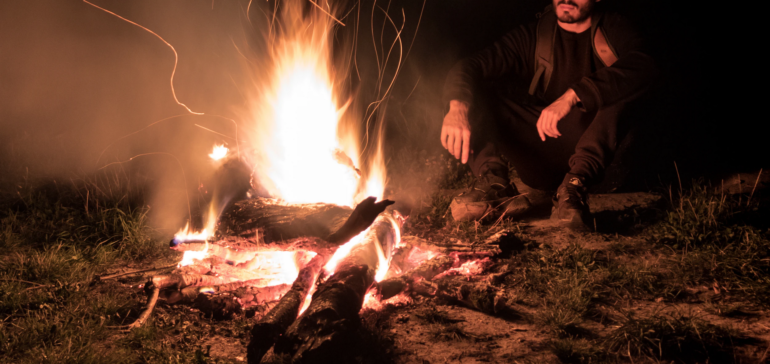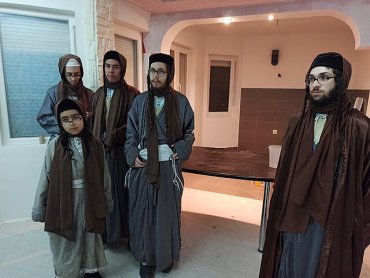
Was the Kabbalah Written by Rabbi Shimon Bar Yochai?
Dear Jew in the City-
I heard that the Kabbalah was written by Rabbi Shimon Bar Yochai. Is that the only opinion or are there other approaches?
Thank you,
Jake
Dear Jake-
Thanks for your question. Bar Yochai isn’t credited with writing “the Kabbalah” – kabbalah is the entire corpus of Jewish mysticism – he’s credited with writing the Zohar, which is the preeminent work of kabbalah. Before we get into that, let’s talk about Rabbi Shimon.
According to the Talmud (33b-34a), the Roman occupiers didn’t take too kindly to some criticisms that Rabbi Shimon had made, so they sought to execute him. Not wanting to be executed, Rabbi Shimon and his son ran away. Originally, they hid in the study hall but that was a pretty logical place to look for them, so they relocated to a cave. God made a miracle and provided them with a carob tree and a spring of water. In order to preserve their clothes, they would disrobe, bury themselves in sand up to their necks and spend their days immersed in intense Torah study. After 12 years, the prophet Elijah informed them that the emperor had died and the decree against them had been annulled.
Rabbi Shimon and his son emerged from the cave but they were so full of spiritual energy that every place they looked was immediately burned, with the result that they had to return to the cave for another twelve months. The gemara then relates some things that Rabbi Shimon did when he returned to the world. At the end of the story, he encounters the one who had informed on him to the authorities. When Rabbi Shimon expressed surprise (or perhaps dismay) that this person was still alive, that informer “turned into a pile of bones.”
Presumably, it was during his time in the cave that Rabbi Shimon – who lived in the second century CE – composed the Zohar. At least such is the traditional attribution. There are those who believe that it was authored by Moses deLeon (13th century, Spain), who passed it off under Rabbi Shimon’s name as a “pious fraud.”
The bulk of claims against Rabbi Shimon’s authorship boil down to anachronisms of various types. Anachronisms are not the kiss of death that detractors like to think. The Talmud was authored by Ravina and Rav Ashi but you’ll find later insertions that were made by the Gaonim. Even the Bible has at least one anachronism! (Shir HaShirim 3:9 contains the Greek word apirion, which was a kind of seat that was carried by bearers. Greek was unknown in Israel in the time of Solomon, who composed the Shir HaShirim, so it must be a fraud, right? Not so fast! We know that King Solomon’s writings were edited by his descendant King Chizkiyahu – see, for example, Proverbs 25:1. Greek may have been unknown in Israel in Solomon’s day but this certainly wasn’t the case in Chizkiyahu’s lifetime!) Even if Rabbi Shimon was the primary author of the Zohar, the difficult, esoteric nature of the material and the oral transmission (at least initially) is a combination crying out for insertions by later transmitters until the work’s ultimate fixed form in writing. (It is believed that the Zohar was a “living document” in this manner for about 300 years after its initial composition.)
In preparing this response to your question, I went online to try to get a few specific examples of anachronisms in the Zohar and I found a whole laundry list of “proofs” that the work couldn’t have been written by Rabbi Shimon. It far exceeded my knowledge of the Zohar and my ability to respond. Rather than cherry pick a few easy examples, I forwarded the list to my friend and colleague Rabbi Yochanan Bechhofer, who is far more well-versed in the Zohar than you, I, or the person who compiled that list of proofs. He was able to respond to each one, rapid-fire and in great depth. Following are just a few of the “proofs” against the Zohar and a snippet of his reply to each. (I have labeled the so-called proofs “Point” and the responses “Counter-Point.” I have also phrased the information in my own words, so my apologies for any damage caused to Rabbi Bechhofer’s thorough responses.)
Point: A great person visited Moses deLeon to learn the history of the Zohar and was told by deLeon’s wife that he had made it up.
Counter-Point: The story is incredibly garbled (and is apocryphal to begin with). The great rabbi was Rav Yitzchak d’Min Akko, an associate of the Ramban. When he traveled to Spain, he met someone who told him in the name of someone else that he heard that de Leon’s wife said something to that effect. It was a big game of telephone, which Rav Yitzchak discounted because of the unlikelihood that deLeon could have composed a work anywhere near the magnitude of the Zohar.
Point: deLeon, lacking a clear sense of history, describes Rabbi Shimon as conversing with people who lived long after his death.
Counter-Point: There are many people across the generations who share the same names. Even in the Talmud, it’s not always clear who a speaker is. There’s more than one Hillel, more than one Rabban Gamliel… The same name is not always the same speaker.
Point: The book includes terms that were not coined until much later.
Counter-Point: No, the book contains terms that weren’t recorded until much later. That isn’t proof that the terms didn’t exist.
Point: The book includes ideas copied from the Kuzari, which came much later.
Counter-Point: The Zohar never quotes the Kuzari. If it has ideas in common, that could just be because they’re authentic concepts in Jewish philosophy.
Point: The book includes the Rambam’s ideas about physics.
Counter-Point: No, the Zohar includes Aristotle’s ideas about physics, which were later repeated by the Rambam. Aristotle lived long before Rabbi Shimon bar Yochai.
Point: The book mentions putting on two pairs of tefillin, a practice that only dates to the 12th century.
Counter-Point: Actually, no. We may call the two types of tefillin “Rashi tefillin” and “Rabbeinu Tam” tefillin but that’s because of their famous debate about the order of the sections in tefillin. The two types of tefillin go back to time immemorial – neither Rashi nor Rabbeinu Tam introduced a new type of tefillin.
Point: The book includes misquotes from the Talmud, which wasn’t even written in Rabbi Shimon’s day.
Counter-Point: No, they weren’t yet written down in Rabbi Shimon’s day, but the Talmud represents ancient wisdom that was transmitted orally over the course of many centuries. Many works of rabbinic literature include the same ideas in slightly (or vastly) different words. (Rabbi Bechhofer gives the example of Pirkei Avos, Avos d’Rabbi Nosson and Pirkei d’Rabbi Eliezer.)
Point: The Talmud and Midrash are unaware of the Zohar.
Counter-Point: Again, failure to mention it by name is not proof of its nonexistence. (Whenever someone tries to “prove” to me that something didn’t exist because the Torah never mentions it, I say, “The Torah also never mentions Avraham using the facilities but I assume that he did.”) Rabbi Bechhofer uses the example that the Talmud discusses learning the mystical topics of the creation account and of God’s “chariot” but it never says where that information can be found. Those things are in the Zohar, which was kept hidden and was only revealed orally and secretly.
There are other things that go against deLeon being the author, such as the fact that the Zohar openly contradicts some ideas that deLeon wrote in books that we know he authored.
Most important, however, is the fact that the Zohar has been universally accepted by the Torah world. Passing one’s own writing off as a famous person’s work is often attempted and rarely successful. It didn’t work for Clifford Irving’s “autobiography” of Howard Hughes and it didn’t work for the “Hitler diaries.” The Pseudepigrapha is a whole corpus of books attributed to various Biblical personages but they didn’t sneak their way into the canon because the experts can tell the difference. Conversely, from the Sefer HaChinuch to the Federalist Papers, it’s always a phenomenon when an anonymous work is accepted as a masterpiece. When it happens, it’s because the truth shines through. If deLeon did write the Zohar, then he lucked into extremely advanced, deep, and esoteric Torah truths far beyond his level.
Our tradition is that Rabbi Shimon authored the Zohar. The Rambam lists 13 principles of faith and believing that isn’t one of them, so if you want to follow the opinion of the academics, such is your prerogative. What’s important is that the Zohar has been accepted as authentic by the Torah world, including our greatest scholars who are in the best position to evaluate its authenticity. Even if one chooses to be cynical about the Zohar’s provenance, one shouldn’t be dismissive of its contents.
Sincerely,
Rabbi Jack Abramowitz
Educational Correspondent
Follow Ask Rabbi Jack on YouTube
If you found this content meaningful and want to help further our mission through our Keter, Makom, and Tikun branches, please consider becoming a Change Maker today.








1 comment
Sort by
Can we start from the other direction? It is certainly true that the Zohar did not appear on the scene until 1,000 years after Rabbi Shimon bar Yochai lived. So other than the fact that “our tradition is that Rabbi Shimon authored the Zohar” (itself a doubtful proposition, being that this is not as universal as you make it seem to be) what evidence is there that the Zohar does have anything to do with Rabbi Shimon?